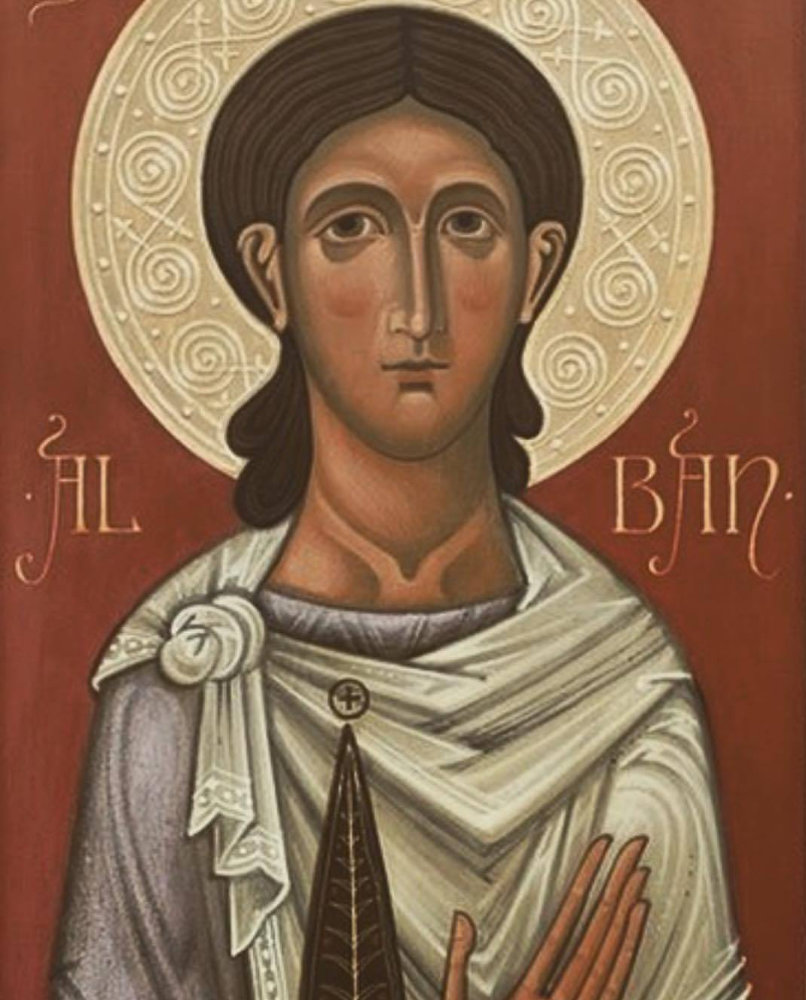St Alban the Protomartyr
Much of what is known about St Alban comes from the Venerable Bede’s Ecclesiastical History, although the first documentary evidence is found in the Life of St Germanus of Auxerre, written by Constantius of Lyons. St Germanus visited Britain in AD429 in order to quell the heresy of Pelagianism and it is recorded that he venerated the Shrine of St Alban.
In AD303 the Roman Emperor Diocletian launched a campaign of persecution against Christians. This was the tenth persecution since the time of Nero and it lasted nearly ten years. Some historians claim that St Alban was martyred fifty or even a hundred years earlier. This would indicate an extremely early Christian presence in Britain.
St Alban was a pagan resident of Verulamium, a city on the same site as the present-day city of St Albans. One day a fugitive asked Alban’s help. The man was a Christian priest, whom tradition remembers as Amphibalus, who was being pursued by the civil authorities. Alban gave him shelter in his own house. Amphibalus, despite the danger, never ceased to sing praises to God. Alban’s heart was so touched by this example of piety that he came to faith in Christ and asked to be baptized.
Eventually soldiers arrived to search the house. In order to help the priest, Alban changed clothes with him. Thus, Amphibalus escaped and Alban presented himself to the soldiers as the fugitive. He was marched off to appear before the judge. It so happened that the judge was offering a sacrifice to the pagan idols when Alban was brought before him. When he saw Alban in the priestly attire, he was enraged because he recognised Alban and realised that the priest has been allowed to escape.
The judge tried to be lenient and offered Alban his freedom if he would offer sacrifice to the idols but the saint steadfastly refused, declaring himself to be a Christian. The judge was so infuriated by Alban’s boldness that he ordered Alban to be taken and scourged, thinking that this would help to bring him to his senses. However, the most savage tortures did nothing to shake Alban’s resolve to be loyal to Christ. Seeing this, the judge ordered him to be put to death.
The traditional site of St Alban’s martyrdom is Holmhurst Hill outside the Roman city. As Alban was being led out of Verulamium, all the townspeople followed him, leaving the place virtually deserted. Between the town and the execution site, there was a river spanned by a bridge. In an attempt to help Alban, the people demolished the bridge. Yet Alban’s desire to go to the Lord was so strong that he prayed for help. Miraculously the river dried up and allowed everyone to cross over as if on dry land. One of the executioners was so overcome by witnessing this wonder that he threw down his sword and begged to be allowed to suffer in place of Alban. His wish for martyrdom was granted by his fellows in the execution squad but with Alban rather than in place of him. Thus he was truly baptized in his own blood but his name is known only to God.
Before the fatal blow was struck, Alban prayed for water. Forthwith a spring appeared out of the ground and the river resumed its course. Here it was, on Holmhurst Hill, that St Alban received his martyr’s crown and entered into his glory. According to Bede’s account, the executioner was not able to look upon the results of his task because his eyes dropped out and fell to the ground. Also it is recorded that the judge was so convinced by the signs and miracles accompanying St Alban’s death that he came to honour the martyr and ordered the cessation of the persecution of Christians in the area.
St Alban was martyred on 22 June. Very soon after his death, the saint’s remains were buried in a church built on Holmhurst Hill. This is where St Germanus, the Bishop of Auxerre, venerated the relics of St Alban. Indeed his devotion to the martyr was so great that, on his return home to his own diocese, he founded a church there dedicated to the memory of St Alban. Writing in AD730, Bede says that at St Alban’s there was a very fine church, which housed the martyr’s relics.
